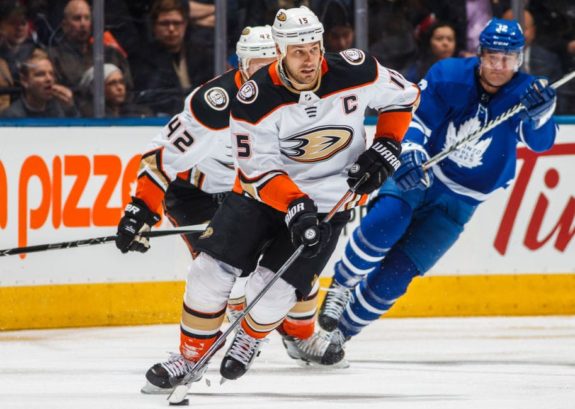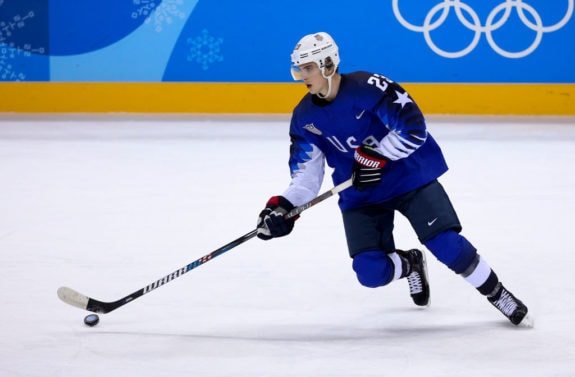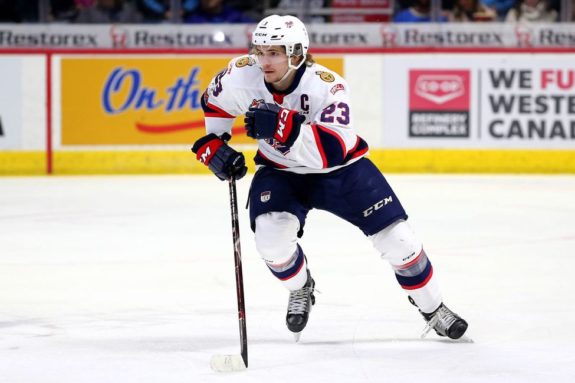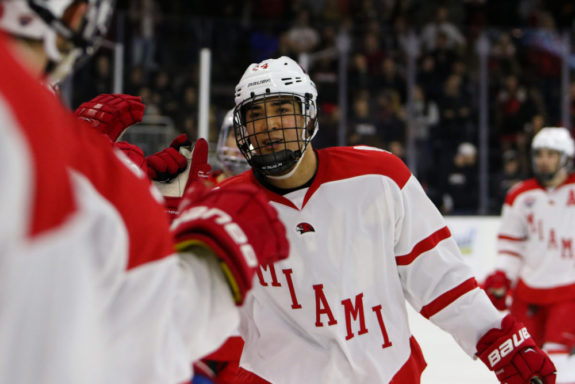This past Monday, Oct. 8, the Anaheim Ducks celebrated their 25th anniversary playing against the Detroit Red Wings, against whom they played their opening game on that date 25 years prior. If veteran fans didn’t recognize many of the names on the backs of the Ducks’ jerseys, they weren’t alone—a slew of rookies joining the team in the 2018-19 season has had many Ducks fans asking, “Who’s that again?”

The home opener lineup was missing quite a few major players, including captain Ryan Getzlaf, Corey Perry, Ryan Kesler, Patrick Eaves, and Ondrej Kase. In their places (and beyond) were rookies Troy Terry, Sam Steel, Max Comtois, Kiefer Sherwood, and Isac Lundestrom. They, along with rookie defenseman Marcus Pettersson, combined for the most Ducks rookies in the lineup in franchise history.
Every forward listed after Terry has made his NHL debut this year, with Terry only playing two games in the previous season. All of these youngsters have shown flashes of excellent talent, but there’s a lack of consistency among most of them.
Learning to Fly: Troy Terry
Terry joined the team last season and played two games towards the end. It was clear that he was a young, small player that needed some time to get comfortable playing in the big leagues as well as a few extra pounds. During the offseason he impressed Ducks fans during the rookie scrimmage as well as the prospect tournament in Vegas, showing a high level of skill and great confidence. Playing on a wing with Steel, Terry generated strong offense and looked primed for another stab at the NHL, where he was rewarded with time on the top line.
Going up against high-quality forwards and top defensive pairings like Vlasic and Karlsson is difficult for even experienced veterans, let alone a small rookie like Terry. During the first four games he has looked increasingly comfortable but has yet to really break out and do something special. Playing near the front of the net has generated the most chances for him, with a couple of tips that were inches away from being his first NHL goal.

Terry’s biggest success so far is no surprise: his shootouts. Although he missed his signature goal on Wednesday against the Coyotes, that same five-hole shot that made him famous during the WJC tournament last year was the decision-maker in the Ducks’ home opener against Detroit.
Towards the end of the Detroit game, coach Randy Carlyle bumped Terry (and Rickard Rakell) down to play with Sam Steel. Against a bit softer competition, Terry looked much better. Once Ducks players return from their injuries, expect him to flourish in a less-pressured role either in the bottom six or in San Diego.
Soaring: Max Comtois
Arguably the biggest surprise of the season, 19-year-old Max Comtois has tallied three points in his first four NHL games, including the first goal of the Ducks’ season (and the sixth-fastest by an NHL player in his debut). At 6-foot-2, 207 pounds, Comtois has the physicality that is necessary for surviving against strong players. His speed and his shot have made him a force to be reckoned with and have led to numerous breakaway chances.
First NHL game, first NHL goal for Max Comtois of the @AnaheimDucks! pic.twitter.com/xWWa94pCM0
— Sportsnet (@Sportsnet) October 4, 2018
Comtois had a stellar finish to his 2017-18 season in the QMJHL, finishing with 85 points in 54 games for the Victoriaville Tigres. Playing on a line with Adam Henqrique and Jakob Silfverberg with the Ducks, he has benefited from having excellent defensive forwards that allow him to be a little more bold on offense. He has shown that he is more than willing to crash into the boards and the net, getting to the dirty places where goals are scored most.
With some slight improvement to his shot and assuming he keeps his discipline in check, he might just be the big left winger the Ducks hoped Nick Ritchie would become.
Learning to Fly: Sam Steel
Steel’s game has been a bit more polarizing than any of the other rookies. His playmaking ability has been just as good as it was advertised to be, including several excellent passes and pass attempts. Sometimes, however, he tries to do a little too much, and that leads to dangerous turnovers.
Still, his smart and very skilled play has earned him the trust of Carlyle and the most ice time of all the rookies, including over 20 minutes on Monday’s tilt against the Red Wings as well as time on the team’s top power play line. With nearly 60% of his zone starts in the defensive zone, it’s clear Carlyle believes he can play a two-way game.

Nerves have appeared to be a factor in Steel’s game, particularly in the early two games. His comfort level seems to improve with every period and he is creating chances, but hasn’t managed to get onto the scoreboard. Now that he is playing with Rakell and Terry, it’s possible that the three will find some chemistry that will hopefully awaken Rakell’s game as well. The three are weaker defensively, though, which led to numerous instances of getting hemmed-in against the Coyotes’ relentless attack.
Steel is a very cerebral player, so it’s great that he’s getting an opportunity to see exactly how the game is played at this level. Just like Terry, he would probably benefit from a reduced role on a lower line or in the AHL, where he can continue to improve his decision-making. While not a slow skater, he (and the team) would benefit from some acceleration work, as well.
Soaring: Kiefer Sherwood
The Ducks signed 23-year-old Kiefer Sherwood to a two-year deal towards the end of the 2017-18 season, which could prove to be one of the Ducks’ best in recent years. An apt player comparison for Sherwood would be his linemate, Andrew Cogliano. Sherwood has the same ultra-high-energy playing style, constantly hounding after the puck. With impressive speed and strong physical play, he has proven to be tough on the forecheck and has forced several mistakes already.

Although Sherwood plays with the same energy as Cogliano, his early games have suggested that there might be even more there. With two points in his first four appearances, he has shown that he can make smart passes and that he has a fairly strong shot. His stick-handling ability looks slick and he has the confidence necessary to actually use the skills he has. Sherwood hasn’t netted a goal yet, but to many Ducks fans it’s clear that his first shouldn’t be too far away.
Learning to Fly: Isac Lundestrom
A few weeks ago, I wrote about how Lundestrom’s poise could make him NHL-ready. After watching his NHL debut earlier this week and his follow-up game days later, I completely stand by my article. Lundestrom, despite being the youngest player on the team, has looked totally comfortable in the lineup, making several very smart defensive plays and creating more than a couple very dangerous chances. My biggest critique so far is that he is playing a little too safe, which is not at all surprising.
In many of his offensive drives, Lundestrom can be seen lingering near the blue line, getting ready to get back on defense. This level of care is surprising for such a young player and shows that he has potential to be an elite defensive forward.

However, I would personally like to see him get a little more involved in the offense and take more chances. The team’s biggest need right now is offensive pressure and he is a strong enough skater that he can add that pressure and still recover quickly enough for the backcheck, as he showed on an incredible chance during the overtime of his debut game.
This kind of thing comes with comfort and experience, so I have no doubt that Lundestrom will pick up on them. With Ryan Kesler back in the lineup, however, his opportunities to play this year may be dwindling. Regardless, I look forward to the young center continue to grow and believe that he will exceed his draft expectations.
Learning to play with the pace, skill, and physicality necessary in the NHL is extremely difficult for rookies. It’s especially hard when you have five (!) other rookies doing it alongside you. So far, the Ducks’ six rookie players have looked very good. As they get more familiar with the league and get some pressure taken off by veteran players returning, they should only get better. Rest assured, Ducks fans: the future looks bright.